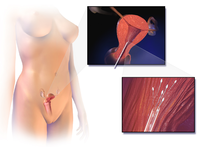
Photo from wikipedia
Assessing the calibration of methods for estimating the probability of the occurrence of a binary outcome is an important aspect of validating the performance of risk‐prediction algorithms. Calibration commonly refers… Click to show full abstract
Assessing the calibration of methods for estimating the probability of the occurrence of a binary outcome is an important aspect of validating the performance of risk‐prediction algorithms. Calibration commonly refers to the agreement between predicted and observed probabilities of the outcome. Graphical methods are an attractive approach to assess calibration, in which observed and predicted probabilities are compared using loess‐based smoothing functions. We describe the Integrated Calibration Index (ICI) that is motivated by Harrell's Emax index, which is the maximum absolute difference between a smooth calibration curve and the diagonal line of perfect calibration. The ICI can be interpreted as weighted difference between observed and predicted probabilities, in which observations are weighted by the empirical density function of the predicted probabilities. As such, the ICI is a measure of calibration that explicitly incorporates the distribution of predicted probabilities. We also discuss two related measures of calibration, E50 and E90, which represent the median and 90th percentile of the absolute difference between observed and predicted probabilities. We illustrate the utility of the ICI, E50, and E90 by using them to compare the calibration of logistic regression with that of random forests and boosted regression trees for predicting mortality in patients hospitalized with a heart attack. The use of these numeric metrics permitted for a greater differentiation in calibration than was permissible by visual inspection of graphical calibration curves.
Journal Title: Statistics in Medicine
Year Published: 2019
Link to full text (if available)
Share on Social Media: Sign Up to like & get
recommendations!